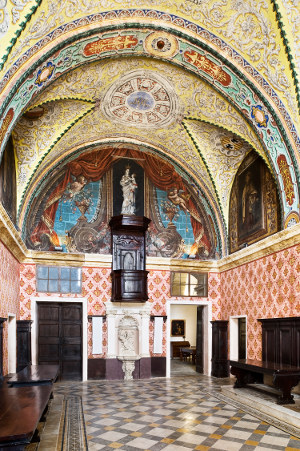
 The Carmelite Church and Priory offers a unique and innovative experience as it is the only priory in Malta to open its doors to welcome regular visitors.
The Carmelite Church and Priory offers a unique and innovative experience as it is the only priory in Malta to open its doors to welcome regular visitors.
This initiative follows two exhaustively intensive years of restoration that have brought this seventeenth century priory back to its former glory. The extensive structural work that has been done in the priory itself can be properly appreciated in the stunning cloister constructed around an idyllic courtyard. Walking around the cloister one is lead into the different original 17th century spaces of the priory which are still in use by the community.
The highlight of the place is undoubtedly the Refectory where the friars congregate for communal meals. It is a rare example of the Baroque concept of the total work of art, where painting, sculpture and architecture come together to create a harmonious whole. Regular events are held in the refectory, the proceeds of which go towards the restoration of the paintings and the breathtaking ceiling of this room which is a masterpiece of ornamentation. On either side of the refectory are the pantry and the kitchen with an original stone stove. Here one can admire a variety of antique tools tools and utensils used in the priory dating back to the eighteenth and nineteenth centuries.
Other areas provide further insight into the everyday communal life of the Carmelite friars. The friars gather at different hours of the day for prayer in the sober Oratory originally dedicated to Bl.Franco of Siena, patron saint of lay brothers. The oratory’s altar goes back to 1670 and the titular painting of the Virgin of Mount Carmel is an interesting work by Mattia Preti and his bottega. Both the altar and the painting were originally in the church until the nineteenth century.
 In the Chapter Hall the Carmelites assemble around the large table to discuss and decide upon important issues. A notable painting in this room is St Cecilia from the workshop of Mattia Preti. This used to be divided in two parts as it adorned the outside of the doors of the organ in the church. Also interesting is the small bozzetto of the dome of the church signed by the artist Santi Cacciaguerra. The items of Maltese furniture in the Chapter Hall have recently been restored, as have the two beautiful Baroque display boxes with statuettes of Carmelite Saints.
In the Chapter Hall the Carmelites assemble around the large table to discuss and decide upon important issues. A notable painting in this room is St Cecilia from the workshop of Mattia Preti. This used to be divided in two parts as it adorned the outside of the doors of the organ in the church. Also interesting is the small bozzetto of the dome of the church signed by the artist Santi Cacciaguerra. The items of Maltese furniture in the Chapter Hall have recently been restored, as have the two beautiful Baroque display boxes with statuettes of Carmelite Saints.
Opened for viewing is a friar’s cell. It testifies to the simplicity of the contemplative life of a religious order. It features only the basic furniture and necessities required by a friar, to conduct a life of solitude and prayer. This particular cell housed Fr Avertanus Fenech, a holy friar who passed away in 1943. Pilgrims and devotees still pay a visit regularly to Fr. Avertanus’ cell. Adjacent to the cell is a bier used for carrying the corpses of dead friars to the crypt for burial.
 While making their way to the church visitors can appreciate a small selection of liturgical vestments. Made by cloistered nuns and noble ladies, these feature exquisitely intricate patterned embroidery. A selection of ecclesiastical silver has also been put on display alongside a number of devotional items in the sacristy.
While making their way to the church visitors can appreciate a small selection of liturgical vestments. Made by cloistered nuns and noble ladies, these feature exquisitely intricate patterned embroidery. A selection of ecclesiastical silver has also been put on display alongside a number of devotional items in the sacristy.
Annexed to the sacristy is a room reserved for the priest and attendants to vest and prepare in prayerful silence before the celebrating of the Sacred Liturgy. Of notable importance is the lavabo, a theatrical piece of sculpture that was used for ritual cleansing.
The Priory is connected to the Carmelite Church from behind the altar. Its arresting impression lies in the fact that it was built to an elliptical shape which creates a very harmonious and welcoming space for congregation and prayer. The paintings in the choir, including the impressive titular of the Annunciation by Stefano Erardi have been thoroughly restored.

Among the most notable paintings in the church are the two works in the large main chapels executed by Michele Bellanti in the mid-nineteenth century. Bellanti was a very competent artist known mostly for his numerous small topographical works representing the Maltese islands. There are also six works by Giuseppe Calì in the church, with the Virgin of Sorrows being a very poignant and devotional work. Finally, the statue of the Virgin of Mount Carmel that is taken out in procession in July, is a triumph of Maltese sculpture. This eighteenth century statue, executed by the little-known Maltese sculptor Andrea Imbroll, is in excellent condition despite its age.